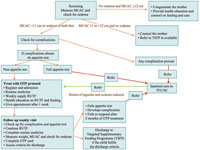10.6.3 Assignment of OTP days
All OTP cases of severe uncomplicated malnutrition need to have a weekly follow-up at the health post. It is usually advisable to fix one day every week for the OTP activity, including follow-up. For example, you may choose every Tuesday to be an OTP day. This will enable caregivers to remember the day of their appointment. If they miss one of the appointments, they can then come on the subsequent Tuesday. If you identify a severely malnourished child on another day of the week, you may decide to give a ration adequate until the usual OTP day, or you may decide to give RUTF ration to cover until the next OTP day in the subsequent week so that the child is not brought back to the health post twice in a a few days. For example, if you identify a severely malnourished child on a Friday while your usual OTP day is on Tuesday, you may decide to give RUTF ration for ten days so that the child comes on the Tuesday that falls ten days later. After that, you can continue the weekly follow-up for the child on every Tuesday. Remember to consider important events in the community that may affect attendance when choosing the most effective OTP day, such as market day or a religious worship day.
This study session looked at the important steps you should take when managing a child with severe acute malnutrition. The flow chart in Figure 10.6 summarises these steps.
You can see from the flow chart the key steps that are necessary when managing severe uncomplicated malnutrition of a child during the different phases of treatment. The red arrows indicate referrals, while the green arrows indicate the children you had referred who have come back to you once their complication improves. The black arrows indicate the flow of treatment as the child progresses over the course of treatment.
10.6.2 Community mobilisation

